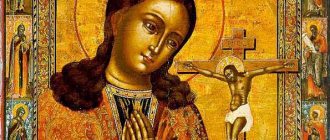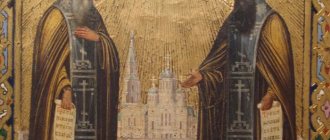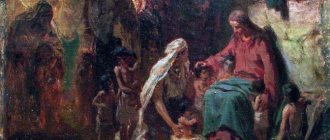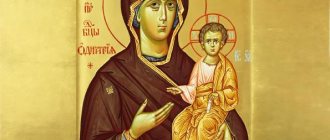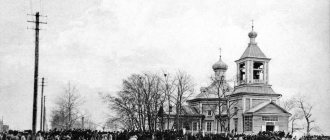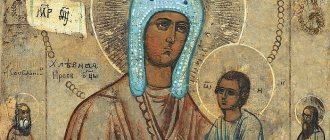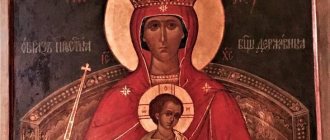On June 16, we Orthodox Christians honor the memory of the Yuga Icon of the Mother of God. At the beginning of the 17th century, the miraculous icon appeared to the Monk Dorotheus, schemamonk of the Pskov-Pechora Monastery.
The Mother of God showed the elder the place where Her image was located, ordered him to take It, take It to the lands of the Yaroslavl diocese and establish a monastery there. The Monk Dorotheos fulfilled the will of the holy Queen of Heaven and set off on the journey with Her divine face. On the way, the elder stopped to rest and placed the icon on a tree.
When he was about to move on and wanted to remove the image of the Mother of God, he was unable to do so. Then he realized that the Mother of God wanted to stay in this place. The Monk Dorotheos built a hut here, and soon people from all over the area began to come here to venerate the icon, who, by their faith, received the help of the Mother of God.
After a while, local residents and pilgrims managed to raise funds for the construction of the monastery, which became known as Yugskaya - based on its location on the Yug River.
Since then, people have prayed in front of this image during epidemics, as well as for a calm, peaceful life and prosperity.
Description and meaning of the image
The Christian shrine became famous for its great miracles in the city of Sozopol in Pisidia (the territory of modern Turkey). The image is made in the Hodegetria (Guide) type. The Mother of God is depicted half-length, holding the infant Christ in her left hand, her head slightly inclined towards the Divine Son, directing the attention of the believers to Him. On the head of the Most Pure Virgin is an omophorion, on top of it is a crown, symbolizing her high title - Queen of Heaven.
A peculiarity of the image is that the right hand does not point to Jesus, as in most icons. The Mother of God blesses Christians with the sign of the sign, reminding people of the need to follow the commandments of Christ and that she is praying for all of us.
The icon is called myrrh-streaming; oil flowed from the hand of the Mother of God, which has healing powers. Many miracles and healings date back to the 6th century. They are attested by people whose words the Holy Church cannot doubt.
How to Pray to Pregnant Women
Pregnant women turn to the icon of the Mother of God “Unidle . This is a slightly unusual image, in which the Mother of God is depicted without a baby in her arms, but with a child in her womb.
It is customary to read the following prayer:
By the way, this icon did not appear just like that. This is an illustration of a scene from the Gospel in which Saint Joseph learned that his betrothed Mary was carrying a child under her heart. He decided to let her go. With one hand the Virgin in the icon wipes away her tears, and with the other she swears that she did not know the man and did not cheat on her betrothed.
As we know, after this conversation, righteous Joseph, who loved Mary very much, did not abandon her, and subsequently raised her Son as his own.
Some non-idle women are afraid to go to church, because you have to stand there a lot, sometimes there is a crush, and some superstitious ladies are even afraid that they will be jinxed (although superstition is not befitting of the Orthodox). In fact, even the Apostle Paul encouraged pregnant women to visit the House of God more often. He said that regularly visiting a place of prayer is very beneficial for young mothers .
Don't be afraid of any evil eye. But concerns about crowds at large services are justifiable. Therefore, you can attend church on non-holiday days, but sit during the service - you should not overwork yourself even for the sake of prayer, so as not to harm the baby.
Is prayer necessary during childbirth?
Even priests do not have a clear answer to this question.
Some say it's not needed. Others advise praying not to the woman herself, but to her closest relatives. Still others claim that in the hour of the most difficult “work”, prayer will support and strengthen.
In any case, you can take a small laminated (its surface can even be wiped with an antiseptic) “Childbirth Assistant” icon to the delivery room . She is considered the strongest at such moments. In addition, on the back of the icon there will be a prayer to this icon.
How to pray for pregnant women
There are special prayers for non-idle women (relatives, friends, neighbors). They are read both in church in front of icons and at home.
Some people pray for both the woman’s health and her child’s health. This is wrong - you need to turn to God only for the mother (she is baptized, but the baby who has not yet been born is not yet).
You can also leave notes . The word “pregnant”, “fruit-bearing” or “non-idle” should be added to her name (ecclesiastical, not secular).
If you are very worried about the health of such a woman, or she is about to give birth, you can order a sorokoust for her health. Thanks to this, priests will pray for her health in the temple for a whole month. Sorokoust is ordered from a candle shop.
History of appearance
The Pisidian icon of the Virgin Mary became famous for its miracles in the 6th century. Already at this time the image was considered ancient, painted many years ago. Where the icon came from and by whom it was created remains unknown. The icon was revered in the city of Sozopol; Christians from surrounding settlements flocked to the shrine to venerate the miraculous image. The miracles performed by the shrine became known from several reliable sources. Information came from different hands; the people who witnessed the miracle lived far from each other.
The Patriarch of Constantinople, Saint Eutyches, lived near Sozopol in the period 565-577. His Lives were compiled by Presbyter Eustathius. The saint's assistant became an eyewitness to the saint's exploits and left notes describing the miracles.
One day an inconsolable married couple came to the saint. Among pious Christians, all babies were born dead, and their spouses were childless. Knowing about the kindness and responsiveness of Eutyches, they asked for advice and prayerful help.
The saint said a prayer, anointed the heads of the spouses with oil from the cross and the Pisidian icon of the Mother of God. The woman was pregnant, Eutychius thought about it after prayers, then assured the parents that the child would be born alive and ordered to name him Peter. Eustathius, who was present, asked the saint what to name the baby if it was a girl.
Firmly and confidently, Eutychius said that there would be a son, and he should be named Peter. The woman safely gave birth to a boy who grew up healthy and strong. Some time later, the couple had another son, named John. The happy parents thanked the saint and the miraculous image of the Mother of God for their help all their lives.
The Monk Theodore Sikeot, during his journey (600), arrived to venerate the Pisidian Icon of the Mother of God. Entering the temple, the saint began to say a prayer, stretching out his hands in front of the holy image. Oil flowed from the hand of the Mother of God with such force that it flooded the eyes of the holy father. This was evidenced by Eleusippus, who accompanied the teacher on the trip. The parishioners who were in the church realized that they were seeing a great ascetic of God.
The great fathers of the church spoke of the myrrh streaming of the Pisidian Icon as a well-known fact confirmed by everyone. Saint Herman wrote about the flow of oil from the hand of the Most Pure Virgin in a letter to Bishop Thomas. At the beginning of the 8th century, persecution of many holy icons spread, but Saint Germanus defended the miraculousness of the Pisidian image and asserted the reliability of the information provided. At the 7th Ecumenical Council, according to a letter from Patriarch Herman, the miraculous nature of the Pisidian Icon of the Mother of God was officially recognized by the holy church.
The meaning of the icon in Orthodoxy
A copy of the Pisidian image was made in the Novospassky Monastery by an unknown icon painter. This list was the favorite image of the mother of Tsar Mikhail Fedorovich. The woman took monastic vows under the name Martha and was a nun. In Russia, the icon is often called the Pisian icon, the list has been known since 1608, and is constantly located in the monastery church.
The Pisidian Icon is revered by Orthodox Russians as miraculous. Memorial Day – September 16th. Icons of the Mother of God enjoy special love and respect in our country. People turn to the Most Pure Virgin for help and support; prayers before the image of the Mother of God have special power. A copy of the ancient shrine can be used for home prayers.
Information: The Pisidian icon of the Mother of God became famous for the flow of myrrh and miracles of healing in the 6th century.
What not to do on June 16, the Day of Remembrance of the Yuga Icon of the Mother of God
Church prohibitions of the day:
1. Don’t think about bad things, don’t be sad and don’t complain about life. All your negative thoughts can come true.
2. Do not share your experiences and secrets even with your loved ones. On this day it is better to be “on your own mind.”
3. Don't quarrel with people, don't gossip and don't use foul language. It is a great sin to do such things on such a bright church holiday.
4. Do not be greedy and do not refuse help to those who ask for it. Otherwise, those around you will also turn away from you.
5. Do not throw a feast for the whole world with dancing and gluttony. You can set the table, invite guests or sit with loved ones, but only modestly, without shouting and festivities.
Drinking alcoholic beverages, swearing, and cruelty to animals are considered a great sin on the Day of Remembrance of the Yuga Icon of the Mother of God.
What do they ask for in front of the image of the Mother of God?
The Mother of God is approached with any requests regarding the well-being of the family, children, and loved ones.
Prayer tradition prescribes turning to the Pisidian image for the following needs:
- for healing and restoration of health;
- in case of infertility, inability to conceive or give birth to a live baby;
- for women's diseases;
- about the health and well-being of children.
Prayers help to gain self-confidence, strengthen faith, and get rid of doubts. Before prayer, you should bring repentance and ask the Lord for forgiveness.
What can you do today June 16th
You can and should:
1. Visit the Church and attend the service.
2. Remember the deceased and light a candle for the repose of their souls. June 16 is filled with Grace and heavenly energy, so sincere prayer and remembrance can help souls be saved.
3. Ask for forgiveness from loved ones and anyone you may have offended. It is a great sin not to forgive a person if he sincerely repents of his mistakes.
Also on the Day of Remembrance of the Southern Icon of the Mother of God, it is allowed to work around the house and work on your plot. You just need to do the work in a good mood and bright thoughts, then the Mother of God herself will come to your aid.
Prayer text
Before the list of the Pisidian image, prayers are read for the Nativity of the Virgin Mary or a request is made in simple words.
Prayer for the Nativity of the Blessed Virgin Mary from the akathist
Oh, Most Holy and God-chosen Virgin, our Lady Theotokos, Queen of Heaven and Earth, given by God to the joy and consolation of the whole world from barren and childless parents! Having been born by God's providence, Thou didst resolve the barrenness of the one who gave birth to Thee, and now make my barren heart fruitful through Thy intercession at the Throne of the Almighty, and make me barren with evil deeds, rotten words and unclean thoughts. Oh, All-Blessed One, may I appear as a child of God, ever-bearing fruitfulness of virtues. Thou hast quenched with Thy most pure Nativity the weeping of our foremother Eve, and Thy righteous parents have delivered the reproach of childlessness, and now quench the weeping and sighing of my much-painful and sinful soul and deliver us all the reproach of our evil deeds, the passions of dishonor and from all enslavement of the enemy. Most of all, grant us, Most Holy Theotokos, the Virgin, on the all-bright day of Thy Nativity, with a pure heart we will understand and remember, with great joy and gratitude, the barren womb of the holy and righteous Anna carried You, and we, not just in words, but especially in our deeds, will glorify with tenderness of heart You, crying out: Glory to Your coming, Pure One. Glory to Your Christmas. Glory to Your virginity, Mother of the Bride. Together with You, grant us to constantly glorify and magnify Your All-Holy Fruit, the Word incarnate, unburntly carried in Your womb, to Him glory befits, honor and worship, with His Beginning Father, and with His Most Holy and Good and Life-giving Spirit, now and ever and ever forever and ever. Amen.
The prayer for the Nativity of the Blessed Virgin Mary is different
Oh, Most Holy Lady, God-chosen Mother of Christ our Savior, asked of God with holy prayers, dedicated to God and beloved by God! Whoever does not please You or who does not sing Your glorious Nativity. Your Christmas was the beginning of the salvation of people, and we, sitting in the darkness of sins, see You, the dwelling of the Impregnable Light. For this reason, the florid tongue cannot sing songs about Thee according to its heritage. Thou art more exalted than the Seraphim, O Most Pure One. Otherwise, accept this present praise from Your unworthy servants and do not reject our prayer. We confess your greatness, we bow down to you in tenderness and boldly ask your child-loving and compassionate Mother, who is quick in intercession: beg your Son and our God to grant us, who have sinned a lot, sincere repentance and a pious life, so that we may be able to do everything pleasing to God and useful to our souls. Let us hate all evil, strengthened by Divine grace in our good will. You are our shameless hope in the hour of death, grant us a Christian death, a comfortable procession through the terrible ordeals of the air and the inheritance of the eternal and ineffable blessings of the Kingdom of Heaven, so that with all the saints we silently confess Your intercession for us and let us glorify the one True God, worshiped in the Holy Trinity, Father and Son and Holy Spirit. Amen.
Prayer to Our Lady
What should I pray to You for, what should I ask of You? You see everything, you know it Yourself: look into my soul and give it what it needs. You, who have endured everything, overcome everything, will understand everything. You, who entwined the Baby in a manger and took Him with Your hands from the Cross, You alone know all the heights of joy, all the oppression of grief. You, who have received the entire human race as adoption, look at me with maternal care. From the snares of sin, lead me to Your Son. I see a tear watering Your face. It’s over me You shed it and let it wash away the traces of my sins. Here I have come, I am standing, I am waiting for Your response, O Mother of God, O All-Singing One, O Lady! I don’t ask for anything, I just stand before You. Only my heart, poor human heart, exhausted in longing for truth, I cast at Your Most Pure feet, Lady! Grant to all who call You to reach the eternal day by You and worship You face to face.
The miraculous icon of the Mother of God “Pisidian” was famous for its miracles many centuries ago. But the glory of the great image still inspires Christians and inspires hope for the help of the Most Pure Virgin in everyday difficulties, troubles and misfortunes.
An idle woman is...
Less often in Russia they said this about a woman busy with work . The word "idle" was also used at that time. It meant “empty,” “idle,” “not occupied with anything.” You can still hear the expression “idly staggering,” that is, “one who walks around without doing anything.” They can also say “an idle word” - these will be words not supported by experience.
But more often (and this is the interpretation that has survived to this day, mainly in church terminology) this is what they said about a woman who carries a child under her heart .
In the Bible, the main task of women was the birth of children (“a woman... is saved through childbearing”). And the more children a believer has, the more Orthodoxy she respects. Pregnancy in the Christian faith is considered the main job of the fairer sex. Hence the non-idleness - after all, carrying a baby under her heart, a woman does not “sit idle.”
Getting rid of idleness
It is easy to guess that life in a marriage, but in a childless status, is called idleness by faith.
Many modern ladies, after being registered at the registry office and even getting married, prefer not to have children for some time, living for themselves. The Orthodox Church considers such women to be sinners and lazy, calling them to repent of this idleness, fast as a sign of humility and pray.
But there are other cases: a couple lives in love and prays for children, but the years go by and still no children. Such women go to the temple and read prayers for deliverance from idleness, that is, simply put, asking the Lord and the saints for pregnancy .
Such an idle woman can:
- confess;
- take communion;
- receive the priest's blessing;
- pray in front of the icons of the Mother of God, Xenia of Petersburg, Mother Matrona.
You can address the images in your own words, simply pouring out your soul to them. There are also special prayers for pregnancy. For example:
Less often, the church calls a woman idle, regardless of her married status, who devotes all her free time to entertainment instead of doing godly deeds (prayers, helping the poor).
